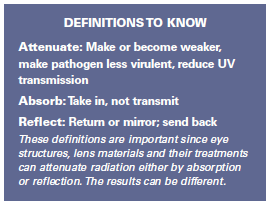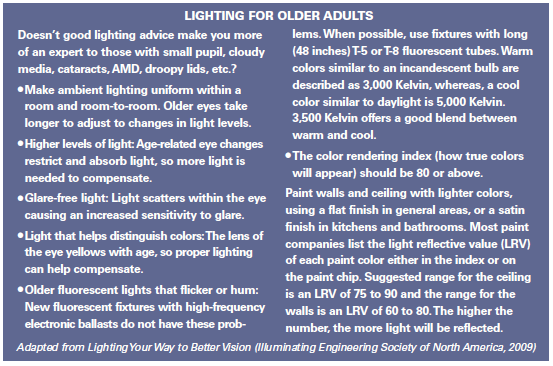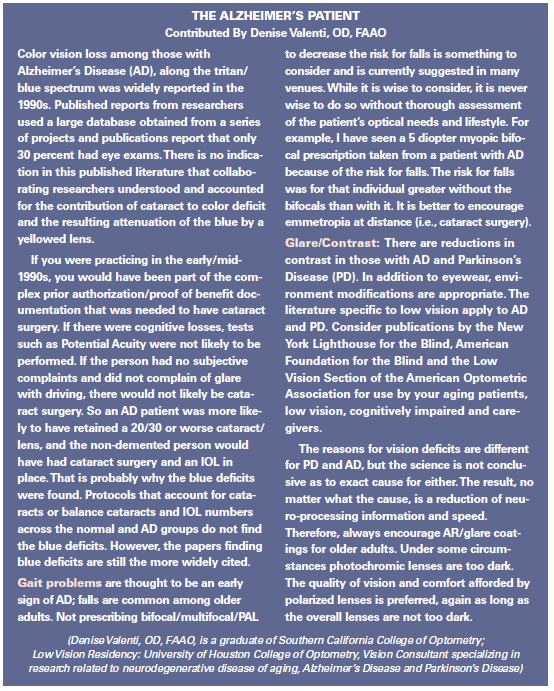Vision's Declaration of Independence - Part Two
UV, HEV and the Aging Eye
By Mark Mattison-Shupnick, ABOM, and John Lahr, OD
Release Date: August 1, 2013
Expiration Date: December 31, 2017
Learning Objectives:
Upon completion of this course, the participant should be able to:
- Learn the spectacle lens methods used to attenuate UV and HEV radiation, important for the aging eye.
- Become a glare expert.
- Understand the effects of aging on color vision.
- Know ways to enhance color contrast for the aging eye.
- Develop a rudimentary understanding of low vision and the resources available to assist the visually impaired senior.
Faculty/Editorial Board:
 John Lahr, O.D., FAAO is vice president of provider relations and medical director of EyeMed Vision Care.
John Lahr, O.D., FAAO is vice president of provider relations and medical director of EyeMed Vision Care.
 Mark Mattison-Shupnick, ABOM is currently director of education for Jobson Medical Information LLC, has more than 40 years of experience as an optician, was senior staff member of SOLA International and is a frequent lecturer and trainer.
Mark Mattison-Shupnick, ABOM is currently director of education for Jobson Medical Information LLC, has more than 40 years of experience as an optician, was senior staff member of SOLA International and is a frequent lecturer and trainer.
Credit Statement:
This course is approved for one (1) hour of CE credit by the American Board of Opticianry (ABO). Course SWJHI523
This course his supported by an educational grant from LUXOTTICA
TRUSTED EYECARE EXPERT
 We didn't mean to get you discouraged about
aging in Part One of this course. However,
being prepared and being able to tell customers
what to do is the key to minimizing the effects
of UV and HEV as we age. It also maintains
your position as a trusted eyecare expert.
We didn't mean to get you discouraged about
aging in Part One of this course. However,
being prepared and being able to tell customers
what to do is the key to minimizing the effects
of UV and HEV as we age. It also maintains
your position as a trusted eyecare expert.
First, recommend to all customers that they get a comprehensive, dilated eye exam annually, especially if over the age of 50. The early detection of age-related eye diseases can ensure treatment when it is most important. A dilated exam also lets the eyecare professional see the effects of systemic diseases like diabetes and high blood pressure or AMD that only a refraction would miss.
Next, attenuate the most UV and HEV radia- tion possible, indoors and outdoors. In order to do this, knowledge of lens attributes as it relates to radiation attenuation is required.
Modern lenses should attenuate UV and HEV using all the properties of the lens, i.e., coatings on the front, lens material, polarizing films, photochromics and the coating applied to the back. The frame should fit well and provide good coverage, and minimize the UV and HEV getting to the eye from the top and sides. Usu- ally in outdoor eyewear that means that the closer the fit and the more wrapped the frame, the better the coverage.
UV/HEV Absorbing Materials: Start with the right lens material since it is the platform to which you’ll add the design and then the lens treatments. However, UV and HEV blocking is the result of the total lens and how it’s con- structed.
The materials that are inherently 100 percent UV absorptive are Trivex material, new Tribrid, polycarbonate, 1.60, 1.67, 1.70 and 1.74 high index. Standard hard resin plastic (about 90 percent UV absorptive) requires additional UV treatment that might adversely affect AR adhe- sion. Crown glass is only about 40 percent UV absorptive. No clear lens materials by them- selves are blue light absorbing (at least not yet). UV/HEV Attenuating Treatments: Lens treatments like photochromics and polarization, or combinations of the two (Transitions Drivewear, NikeMax Transitions, others) are 100 percent UV absorptive. For blue light, lenses with color treatments provide selective absorption using either polarizing films or tints. Some sun lenses are specifically designed to filter or selectively absorb more of the HEV than others (Vision-Ease Coppertone gray and brown, Oakley VR28 Black Iridium Polarized, others). Therefore, knowing the transmission characteristics of lenses before and after coating allows you to deliver the best outdoor lenses that block UV and HEV. Request transmission curve charts from your lab or lens manufacturers (total lens = lens material + coating and/or treatment) to know the best lenses to attenuate short wavelength, highenergy blue light outdoors. Also ask for the lab's recommendations.

You know that all outdoor lenses should be no-glare AR, on the back surface. This reduces the brighter appearing back surface reflections especially because of their very large size (the concave mirror acts like a convex lens and magnifies the reflection). Consider switching to a UV-attenuating back surface AR since there is significant back-reflected UV from lenses that can enter the pupil.
 The same surface reflectance is also true of
blue light outdoors. On the lens front, consider coatings that increase reflectance of the
short wavelength blue while the back reduces
the reflectance.
The same surface reflectance is also true of
blue light outdoors. On the lens front, consider coatings that increase reflectance of the
short wavelength blue while the back reduces
the reflectance.
When outdoors, frames that provide better coverage with increased face form can help; wrap frames do the best job. Yes, it's a balancing act between the fashion, style and protection in sunwear. Use these great lens tools, and make a difference in the great looks of sunglasses while you deliver great performance.
Indoor Lenses: Lastly, the ability to attenuate UV indoors is easily accomplished using UVtransmitting coatings and UV-absorbing lens materials. However, attenuating blue light indoors has been difficult in clear lenses since any of the blue-absorbing tint-type treatments added significant yellow to the lens, until now.
New blue-light attenuating AR lenses are available. Some examples are Nikon SeeCoat Blue, HOYA Recharge, PFO Global iBlu, Quantum Innovations RB Tech, Laramy-K UVARity, Unity BluTech and Essilor Crizal Prevencia. Each of these lenses handles blue attenuation somewhat differently. Some use absorption, others reflectance and vary the properties of the front and back surfaces differently to produce the desired attenuation. Please contact your lab for technical details and availability. Also, see the blue light CE course, "Handling the Blues" at 2020mag.com/CE.
COLOR, SLEEP AND CONTRAST
Selectively managing the color spectrum through lenses is important. Altering normal color perception through glasses can have improved effects for sports and general lens use because lenses can be made to increase the vibrancy of what is seen. For the aging eye, this can be an important stimulus when cataracts, cloudy media, small pupil, retinopathy or any of a variety of special needs has compromised the visual system.
When a yellowing crystalline lens scatters blue wavelengths, it can mask differences in the shades of violets, blues and grays. That makes these colors appear duller. An example may be a curb where it becomes impossible to distinguish the edge. That is also true for overcast days or dusk. This can slow reaction time, a critical driving requirement. Therefore, for outdoor eyewear use spectacle lenses that improve contrast. They are beneficial to the aging eye's requirement for all daily tasks.
 From "Aging of Eyes Is Blamed for Range of
Health Woes" (L. Tarkan, New York Times,
February 20, 2012), "The gradual yellowing of
the lens and the narrowing of the pupil that
occur with age disturb the body's circadian
rhythm, contributing to a range of health
problems… In a study published in The
British Journal of Ophthalmology, Dr.
Mainster and Dr. Turner estimated that
by age 45, the photoreceptors of the
average adult receive just 50 percent of
the light needed to fully stimulate the
circadian system. By age 55, it dips to 37
percent, and by age 75, to a mere 17
percent." The Journal study went on to
say, "Researchers in Sweden studied
patients who had cataract surgery to
remove their clouded lenses and
implant clear intraocular lenses. They
found that the incidence of insomnia
and daytime sleepiness was significantly
reduced. Another study found improved reaction time after cataract surgery."
From "Aging of Eyes Is Blamed for Range of
Health Woes" (L. Tarkan, New York Times,
February 20, 2012), "The gradual yellowing of
the lens and the narrowing of the pupil that
occur with age disturb the body's circadian
rhythm, contributing to a range of health
problems… In a study published in The
British Journal of Ophthalmology, Dr.
Mainster and Dr. Turner estimated that
by age 45, the photoreceptors of the
average adult receive just 50 percent of
the light needed to fully stimulate the
circadian system. By age 55, it dips to 37
percent, and by age 75, to a mere 17
percent." The Journal study went on to
say, "Researchers in Sweden studied
patients who had cataract surgery to
remove their clouded lenses and
implant clear intraocular lenses. They
found that the incidence of insomnia
and daytime sleepiness was significantly
reduced. Another study found improved reaction time after cataract surgery."
From "Sunlight Filters: Eye Protection and Improvement of Visual Performance": "Optimize the balance between protection, comfort and color vision. Take into account the sensitivity curve of human eyes to solar radiation. This curve shows that the eye has little sensitivity to violet components between 380 and 430 nm (and as such, they have little impact on the vision mechanism), which are at the same time the visible radiation with the highest energy. Therefore, the ideal choice is to obtain a transmittance curve starting from 0 at 380 to 400 nm, and progressively rises up to 500 nm, thus opening progressively a wider and wider window as the radiation becomes less dangerous and at the same time, more important for color vision." (Dr. G. Marusi, Quality Control Manager, Intercast Europe S.p.A.)
BEHIND THE WHEEL
Lenses, color, selective absorption, visual reaction time and aging all affect driving ability. Since a car is a lethal weapon, recommend the best eyewear for driving.
Opticians, in one-on-one conversations are likely driving confidence counselors. After all, we've made glasses for many people for years, and they often confide in us things they won't tell the doctor. Get them out of that cheap pair of plano sunglasses they bought at the gas station that they quietly wear together with their other glasses while driving. Demonstrate to every senior how the right color (filter) and treatment can enhance their outdoor vision while it protects their eyes.
One last comment on driving: Since new traffic signals, warning signs and emergency vehicle lights are LED-based, ANSI-suggested transmission values for sun lenses ensure traffic signal recognition. Explain to your customer that choosing the right pair of quality sunwear is not trial and error—it requires a bit of counseling. Passing the Vision Exam: Have you ever been asked if there is anything you can do to help older adults pass their driving exam, see better at night, etc.? Be sure that your customers have a recent comprehensive, dilated eye exam so all the things that affect vision can be identified. Additionally, talk to the doctors for which you get prescriptions. Review the parts of this CE with them for details, information and their awareness of the lens and frame choices that are at your disposal. Next request that the prescription lists the best-corrected acuity for each eye when it is not 20/20 (distance) or J-1 (near). In this way, one can avoid setting up an expectation that new glasses will make everything clear.
LOW VISION AND THE VISUALLY IMPAIRED
Why is low vision a subject in a course on UV, HEV and the aging eye? If the result of accumulated radiation (AMD, diabetic retinopathy, cataract) leaves a person with a best-corrected acuity of less than 20/60, in the better-seeing eye, they are described as being visually impaired. That's different than the customer whose vision is 20/200, for example, but with glasses or contact lenses sees better than 20/40. A person whose vision is correctable to 20/40 or better is not considered visually impaired. Interestingly, that is also the vision requirement for driving, i.e., 20/40 or better vision in one eye or both.
If a prescription lists the best-corrected acuity as 20/60 for example, that customer will have difficulty with shopping, cooking, reading labels, TV and other daily tasks. Managing those issues is a mixture of a low vision assessment, tools like magnifiers, electronic aids, closed-circuit TVs and training, both in using the tools available and for overall mobility.

My wife spent her career as an orientation and mobility instructor for the blind and visually impaired. This included Braille, cane travel, electronic aids, independent living skills and mobility training. Often, her clients were told by their physician, "There is nothing I can do for you." That was said in the context of improving the patient's acuity but lacked the insight that a motivated patient could benefit from a low vision assessment by a qualified specialist and referral to any of a variety of low vision services. For example, your state may have an agency dedicated to assisting the blind and visually impaired maintain and improve their independent living skills. Search "rehabilitation services for the blind and visually impaired" online to find the office nearest you. Optometry schools teach low vision assessment and practice low vision examination in their clinics. Orientation and mobility specialists can teach the visually impaired ways to adapt to their work or transportation requirements, to be independent in their home and provide counsel for the families of the visually impaired. For more information, see The Vision Council's website "What is Low Vision" (whatislowvision.org), the Low Vision brochure from the National Eye Institute (www.nei.nih.gov/health/lowvision/LowVisPatBro2.pdf), Lighthouse International (www. lighthouse.org) and any variety of websites that offer magnifiers and electronic aids. An exam by a low vision specialist can pinpoint the problem and suggest the tools and a plan to help minimize the effects of the disability.
SPREADING THE WORD
Become an expert by understanding the effects of UV and HEV for every one of your aged customers. However, it's a bit like selling progressives; if you are not presbyopic, it is hard to understand the problem. Regardless, be empathetic, tease out the real problems and use the tools that you have in high contrast outdoor AR lenses and clear and photochromic indoor AR lenses. Let your customers know of your expertise in an e-mail newsletter that perhaps describes three facts about the effects of UV and the products that address that issue.
Add Facebook posts as a service to your customers and to communicate the opportunity that you have in the products and expertise of your office. Each patient card represents a potential family in which there is a senior whose eyes require care. For those whose vision is affected by the long-term affects of UV and HEV, consider a personal letter addressing their care plan. Notes to them about the importance of good outdoor eyewear, the right darkness and color, photochromics and a re-examination schedule can make a difference maintaining the sight that they do have.

CONCLUSION
It may be the end of this course but there's more for you to do. First, continue to study about age-related UV and HEV issues.
Next, discuss UV and HEV with every patient. That opens the door to being more than just a place to buy glasses. The customer should see you as an expert whose advice they seek. Lastly, know the lens solutions availableand be able to describe them to customers in simple terms.
Ensuring visual independence is a lifelong goal. It's an optician's work to ensure only minimal daily doses of UV and HEV. However, once your customer is aged, the requirements to maintain independence are critical.
